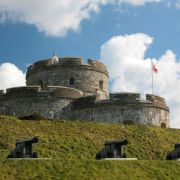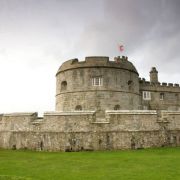
Trelowarren lies on the Lizard peninsula, close to the River Helford. This spot has been inhabited for thousands of years and the Iron Age Halliggye fogou is very near. The estate was mentioned in the Domesday Book and has been owned by the Vyvyan family since the first part of the 15th century. Even then, there was mention of an existing garden and there was certainly a deer park in Elizabethan times. Both house and garden were remodelled in the Georgian era and subsequently a ha-ha was created to separate the gardens from the surrounding moorland.
Pleasure gardens were created to the south of the main house and three walled gardens were created. Lady Vyvyan's Garden is one of these and it has particularly interesting walls containing gothic windows and a turret. Another of the enclosed gardens has a central temple style building, which was originally intended to be a library. This garden was part of an ambitious project for a botanical flower garden based on the Linnaean classification system. An interesting seed house has survived within this garden.
Lawns surround the house and wide stone steps lead to raised gardens above these. The pleasure gardens contain the highest point in the gardens, and the highest point on the whole of the Lizard. This fifty foot high mount was originally called Three Seas point, as the coast on all three sides of the peninsula could be seen from this spot. The view today is inhibited by the many trees in the surrounding woodlands.
Trelowarren is particularly interesting because there are still many different styles of garden to be seen here. Formal geometric gardens have survived beside the more open aspects favoured by such later gardeners as Capability Brown. The Pleasure Garden is a good example of a small Rococo garden. The restoration of the grounds is an ongoing project.
In addition to the gardens and house, there are a number of outbuildings which have been converted to various uses. These include a restaurant, a shop and a local craft display centre. The estate is open each day from April until September every year.







